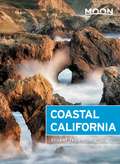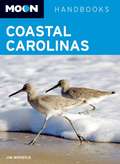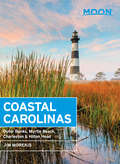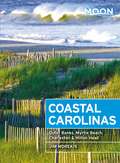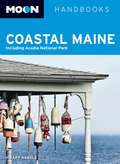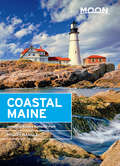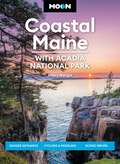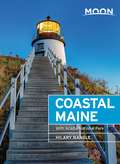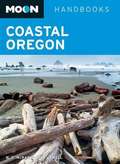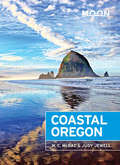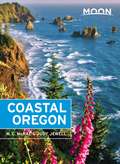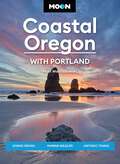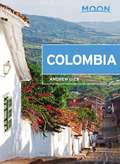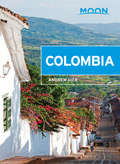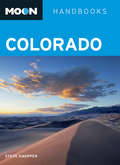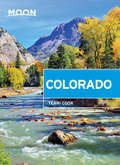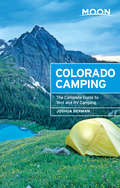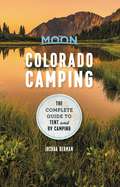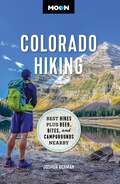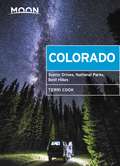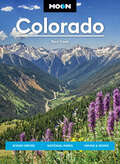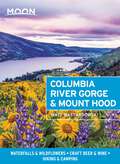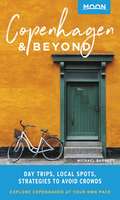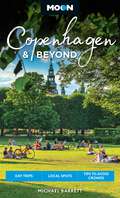- Table View
- List View
Moon Coastal California (Travel Guide)
by Stuart ThorntonFrom foggy cliffs and towering redwoods to warm sands and legendary surf, explore the best of the golden coast with Moon Coastal California. Inside you'll find:Flexible itineraries including six days in Central California, five days on the North Coast, and multiple road trip itineraries that can be combined into an epic two-week Pacific Coast road tripStrategic advice for families, adventure seekers, romantic getaways, outdoor enthusiasts, foodies, and moreThe top beaches for surfing, wildlife viewing, solitude, scuba diving, snorkeling, hiking, and moreUnique experiences and can't-miss highlights: Soak up the solitude and rugged beauty of the North Coast beaches, or opt for sun and sand in San Diego. Explore the world-class museums and plunging city streets of San Francisco, sip your way through Napa and Sonoma, or gaze at skyscraping redwoods in Muir Woods. Catch a wave in a classic surf town, explore sea caves by kayak, or hike winding cliffside trails. Feast on local Dungeness crab, sample stouts at a coastal microbrewery, or find the best tacos in Los Angeles Full-color photos and detailed maps throughoutExpert advice from Monterey local and surfer Stuart Thornton on where to stay, where to eat, and how to get aroundBackground information on California's landscape, plants and animals, history, and cultureHandy tips for international visitors, seniors, families with kids, LGBTQ+ travelers, and travelers with disabilities With Moon Coastal California's local insight and practical know-how, you can plan your trip your way.Hitting the road? Try Moon California Road Trip. Headed to the national parks? Check out Moon Death Valley National Park or Moon Yosemite, Sequoia & Kings Canyon.
Moon Coastal Carolinas
by Jim MorekisMoon South Carolina author Jim Morekis covers the best of the North and South Carolina coasts, including Beaufort, Wilmington, the Cape Fear Region, Myrtle Beach, Charleston, and the Lowcountry. Morekis offers his inside knowledge on the best beaches, golfing, historic parks, and seaside dining from the Down East to the Grand Strand. Whether you're looking for a coastal weekend getaway or a longer vacation, Moon Coastal Carolinas caters to a range of travel budgets. With unique travel strategies such as "Maritime Legacy" and "The Green Coast: An Environmental Tour," Moon Coastal Carolinas gives travelers the tools they need to create a more personal and memorable experience.
Moon Coastal Carolinas: Outer Banks, Myrtle Beach, Charleston & Hilton Head
by Jim MorekisTravel writer Jim Morekis shares the must-see sights and local secrets of the North and South Carolina coasts, from the grand houses of Charleston to the breezy beaches of the Outer Banks. Morekis provides unique travel ideas for visitors such as "Coastal Carolinas for Couples” and "Carolina Lighthouses.” Including expert advice on how best to revel in the celebrations of Wilmington's flower-festooned Azalea Festival and when to visit Myrtle Beach to get the best value, Moon Coastal Carolinas gives travelers the tools they need to create a more personal and memorable experience.
Moon Coastal Carolinas: Outer Banks, Myrtle Beach, Charleston & Hilton Head (Moon Handbooks Ser.)
by Jim MorekisMoon Travel Guides: Discover the Carolinas in a New Way! Get to know this historic and beautiful stretch of American coastline, from the "wreckers" of the Outer Banks to the "snowbirds" of Hilton Head with Moon Coastal Carolinas.What you'll find in Moon Coastal Carolinas:Expert coverage from local author and born-and-bred southerner Jim Morekis. From climbing lighthouses in the Outer Banks to eating shrimp and grits in Charleston, Jim brings you his favorite things to do in the Coastal Carolinas.Full-color, vibrant photos and detailed directions and maps for exploring on your ownIn-depth coverage of The Outer Banks, North Carolina Central Coast, Charleston, Myrtle Beach and the Grand Strand, Wilmington and Cape Fear, South Carolina Low CountryStrategic itineraries in an easy-to-navigate format, such as "The Best of the Coastal Carolinas", "Coastal Carolinas for Couples", and "African American Heritage"Activities and ideas for every traveler: Sample seafood (fried, grilled, or boiled) from Elizabeth City to Port Royal, but don't forget about the barbecue! Relax on the beach or explore the hundreds of windswept waterways by boat or kayak. Go hang-gliding for a shot of adventure, or go bird-watching and enjoy nature's stillness. See the historic sights of Charleston, the site of humankind's first flight at Kittyhawk, or just breathe in that salty sea airCurrent background information on the landscape, culture, history, and environmentTips for travelers on health and safety, recreation, transportation, and accommodationWith Moon Coastal Carolinas' practical tips, myriad activities, and an insider's view on the best things to do and see, you can plan your trip your way.Heading inland? Try Moon South Carolina or Moon North Carolina! Looking for an adventure on the open road? Check out Moon Blue Ridge Parkway Road Trip.
Moon Coastal Maine
by Hilary NangleAward-winning writer and Maine native Hilary Nangle offers her unique perspective on this famed stretch of New England Coastline, from the gourmet restaurants of Portland to the idyllic island community of Monhegan. Hilary is the perfect tour guide, providing suggestions for great trips such asIcons of the Maine Coast and Lighthouses, Lobster, and L. L. Bean. Packed with information on dining, transportation, and accommodations, Moon Coastal Maine has lotsof options for a range of travel budgets. Every Moon guidebook includes recommendations for mustseesights and many regional, area, and city-centered maps. With detailed information on finding deals at L. L. Bean's outlet store and eating in the open-air lobster wharves of Penobscot Bay, Moon Coastal Maine gives travellers the tools they need to create a more personal and memorable experience. With expert writers, first-rate strategic advice, and an essential dose of humor, Moon Handbooks are the cure for the common trip.
Moon Coastal Maine
by Hilary NangleAward-winning writer and Maine native Hilary Nangle offers her unique perspective on this famed stretch of New England coastline, from the gourmet restaurants of Portland to the idyllic island community of Monhegan. Nangle suggests itineraries for great trips, such as "Icons of the Maine Coast" and "Lighthouses, Lobster, and L.L. Bean." With detailed information on finding deals at outlet stores and eating in the open-air lobster wharves of Penobscot Bay, Moon Coastal Maine gives travelers the tools they need to create a more personal and memorable experience.
Moon Coastal Maine: Including Acadia National Park
by Hilary NangleAward-winning writer and Maine native Hilary Nangle offers her unique perspective on this famed stretch of New England coastline, from the gourmet restaurants of Portland to the idyllic island community of Monhegan. Nangle suggests itineraries for great trips, such as "Icons of the Maine Coast" and "Lighthouses, Lobster, and L.L. Bean". With detailed information on finding deals at outlet stores and eating in the open-air lobster wharves of Penobscot Bay, Moon Coastal Maine gives travelers the tools they need to create a more personal and memorable experience.
Moon Coastal Maine: Seaside Getaways, Cycling & Paddling, Scenic Drives (Travel Guide)
by Hilary NangleExperience the best of Maine's spruce-studded islands, classic shoreline villages, and rugged character with Moon Coastal Maine. Inside you'll find:Strategic, flexible itineraries like a long weekend Down East, five days in Acadia, and a two-week road trip Must-see highlights and unique experiences: Bike through timberland forests or take a lighthouse cruise down the Kennebec River. Sample wild blueberries, farmstead cheeses, and preserves from roadside farm stands, find the best beachfront lobster shack, or mingle with locals over a "chowdah suppah." Discover maritime history in a traditional fishing village or explore pedestrian-only islands packed with hiking trails. Watch the boats sway in a quiet harbor, unwind on a sandy pocket beach sandwiched between two headlands, or immerse yourself in the secluded wilderness of Mount Desert Island and Acadia National Park Honest insight from Maine native Hilary Nangle on when to go, where to eat, and where to stay, from budget campgrounds to historic inns Full-color photos and detailed maps throughoutRecommendations for getting there and getting around by plane, car, train, or bus Thorough background on the culture, environment, wildlife, and history With Moon's practical tips and local know-how, you can experience the best of coastal Maine. Exploring inland? Try Moon Maine. Hitting the road? Check out Moon New England Road Trip. About Moon Travel Guides: Moon was founded in 1973 to empower independent, active, and conscious travel. We prioritize local businesses, outdoor recreation, and traveling strategically and sustainably. Moon Travel Guides are written by local, expert authors with great stories to tell—and they can't wait to share their favorite places with you. For more inspiration, follow @moonguides on social media.
Moon Coastal Maine: With Acadia National Park (Travel Guide)
by Hilary NangleExperience the best of Maine's spruce-studded islands, classic shoreline villages, and rugged character with Moon Coastal Maine. Inside you'll find:Strategic, flexible itineraries like a long weekend Down East, five days in Acadia, and a two-week road trip, designed for history buffs, foodies, beach-goers, outdoor adventurers, and moreMust-see highlights and unique experiences: Bike through timberland forests or take a lighthouse cruise down the Kennebec River. Sample wild blueberries, farmstead cheeses, and preserves from roadside farm stands, find the best beachfront lobster shack, or mingle with locals over a "chowdah suppah." Discover maritime history in a traditional fishing village or explore pedestrian-only islands packed with hiking trails. Watch the boats sway in a quiet harbor, unwind on a sandy pocket beach sandwiched between two headlands, or immerse yourself in the secluded wilderness of Mount Desert Island and Acadia National ParkHonest insight from Maine native Hilary Nangle on when to go, where to eat, and where to stay, from budget campgrounds to historic inns Full-color photos and detailed maps throughoutRecommendations for getting there and getting around by plane, car, train, or busThorough background on the culture, environment, wildlife, and historyWith Moon's practical tips and local know-how, you can experience the best of coastal Maine.Exploring inland? Try Moon Maine. Hitting the road? Check out Moon New England Road Trip.
Moon Coastal Oregon
by W. C. Mcrae Judy JewellOregon residents and outdoor enthusiasts W. C. McRae and Judy Jewell give their unique perspectives on coastal Oregon, from the best places to grab a seaside snack to the best hikes along the Coastal Trail. With endless options for inn-hopping and surfing along the state's southern beaches,Moon Coastal Oregongives travelers the tools they need to create a more personal and memorable experience.
Moon Coastal Oregon
by W. C. Mcrae Judy JewellOutdoor enthusiasts W. C. McRae and Judy Jewell share their extensive knowledge of coastal Oregon, from the best places to grab a seaside snack to the most scenic hikes along the Coastal Trail. McRae and Jewell also outline a variety of suggested travel strategies, including Riding the Pacific Waves, Foraging the Coast, and Coastal Road Trip-a 10-day itinerary for a tour of the entire coast. With endless options for inn-hopping and surfing along the state's southern beaches, Moon Coastal Oregon gives travelers the tools they need to create a more personal and memorable experience.
Moon Coastal Oregon (Travel Guide)
by Judy Jewell W. C. McRaeMake Your Escape with Moon Travel Guides!Discover the incredible outdoor adventure and charming seaside towns that define this dramatic coastline with Moon Coastal Oregon. Inside you'll find:Strategic, flexible itineraries that can be adapted for your budget and timeline, from a long weekend getaway to a ten-day road trip covering the entire Oregon coast, designed for campers, surfers, culture mavens, wildlife enthusiasts, romantics, and moreActivities and ideas for every traveler, season, and budget: Hop in the car and take the Pacific Coast Highway for a stunning coastal road trip, stopping along the way to explore charming harbor towns. Spot sea lions, puffins, and marine birds, go whale-watching, or zip up a wetsuit and catch a wave. Camp among sand dunes and shipwrecks, gaze at free-swimming sharks at the Oregon Coast Aquarium, or visit one of Lewis and Clark's expedition landmarks. Forage for your own dinner of crabs, clams, and mussels, or relax with a beer at a local fish shack. Hike through any of the 80 state parks along the coast, and discover the best photo ops for that perfect Pacific sunset Where to find the top outdoor adventures, whether you're looking for water sports, fishing, hiking, biking, or whale-watchingExpert insight from Oregon locals Judy Jewell and Bill McRae on when to go, how to get around, and where to stay, from cozy seaside inns to wilderness campsitesFull-color photos and detailed maps throughoutDetailed coverage of the North, South, and Central coasts, including small towns, undiscovered beaches, and larger hubs like Astoria, Newport, and Lincoln CityThorough information, including background on the landscape, plants and animals, climate, and local cultureWith Moon Coastal Oregon's expert tips, myriad activities, and local know-how, you can plan your trip your way.Exploring more of the West Coast? Check out Moon Pacific Northwest Road Trip. Need a cosmopolitan fix? Try Moon Portland, Moon Seattle, or Moon Vancouver.
Moon Coastal Oregon: Scenic Drives, Marine Wildlife, Historic Towns (Travel Guide)
by Moon Travel Guides Matt WastradowskiFrom stunning coastline to charming towns to wildlife watching, find your adventure with Moon Coastal Oregon. Inside you'll find:Flexible itineraries, including a weeklong road trip to experience the best of the Oregon Coast The top outdoor adventures: Go tidepooling, watch for migrating whales, and see hundreds of sea lions. Hike along epic coastal dunes, take a surfing lesson, and catch a sunset at iconic Haystack Rock. Join a fishing charter, camp beside the ocean, or take a jet boat tour to spot wildlife on the Rogue River. Can't-miss experiences and unique activities: Feast on fresh seafood in quaint seaside towns, check out Astoria's craft beer scene, or try tasty treats at the famous Tillamook cheese factory. Climb to the top of historic lighthouses, explore a shipwreck, and learn about local maritime history. Expert insight from Oregon local Matt Wastradowski on when to go, how to get around, and where to stay Full-color photos and detailed maps throughoutThorough background information on the culture, landscape, climate, and wildlife, plus handy recommendations for international visitors, families with kids, travelers of color, women travelers, and more With Moon's expert tips and local know-how, you can experience the best of Coastal Oregon. Exploring more of the state? Try Moon Oregon or Moon Columbia River Gorge & Mount Hood. Looking for outdoor adventure? Check out Moon Oregon Hiking.About Moon Travel Guides: Moon was founded in 1973 to empower independent, active, and conscious travel. We prioritize local businesses, outdoor recreation, and traveling strategically and sustainably. Moon Travel Guides are written by local, expert authors with great stories to tell—and they can't wait to share their favorite places with you. For more inspiration, follow @moonguides on social media.
Moon Colombia
by Andrew DierThis full-color guide to Colombia includes vibrant photos and helpful planning maps.Longtime resident Andrew Dier shows travelers the way to the best of Colombia-whether it's dancing and dining in Bogotá or hiking to the Ciudad Perdida. Along with his in-depth coverage, Dier includes unique trip ideas, including Most of the Coast and Jungle Exploration. Complete with details on finding the best secluded beaches and the most stunning archeological sights, Moon Colombia gives travelers the tools they need to create a more personal and memorable experience.This ebook and its features are best experienced on iOS or Android devices and the Kindle Fire.
Moon Colombia: Including Colombia's Coffee Region (Travel Guide)
by Andrew DierMoon Travel Guides: Your World, Your WayIdyllic colonial towns and fast-paced cities, jaw-dropping mountains and stunning beaches: see it all with Moon Colombia.Strategic travel plans with adaptable itineraries for exploring the wild coasts, historic towns, and rural countryside, plus a multi-week trip covering the best of ColombiaCurated advice from local writer Andrew Dier, who provides his American-expat perspective on his adopted home Full-color maps and photos for exploring on your ownActivities for every traveler: Stroll along the bougainvillea-strewn cobblestone streets of Cartagena, or explore wildlife preserves, and hike diverse biomes from the Andes to the Amazon. See the ancient ruins of Ciudad Perdida and visit indigenous communities to learn about Colombia's past and present. Swim in the Carribean, or spot humpback whales in the Pacific. Immerse yourself in regional festivals to experience Colombia's diverse music and dance traditions, enjoy nouvelle Colombian restaurants and hopping nightlife of Bogotà, or the perfect weather and locally-grown coffee of MedellínIn-depth coverage of Bogotá, Cartagena and the Caribbean Coast, Boyacá and the Santanderes, Medellín and the Coffee region, Cali and Southwest Colombia, the Pacific Coast, San Andrés and Providencia, and the Amazon and Los LlanosCurrent background information on the landscape, culture, history, and environment, as well as a handy Spanish phrasebook, all packaged in a book light enough to fit in your carry-onEssential insight for travelers on trekking through jungles, accessing remote mountain ranges, and exploring ancient ruins, with tips for traveling safely and respectfully engaging with the local cultureWith Moon Colombia's practical tips, myriad activities, and an insider's view, you can plan your trip your way.Only visiting one region? Try Moon Bogotá, Moon Medellín or Moon Cartegena & Colombia's Caribbean Coast. Country-hopping in South America? Check out Moon Peru or Moon Ecuador & the Galápagos Islands.
Moon Colorado
by Steve KnopperTravel suggestions include: the 10-day ski bum's tour, 10 days in the rockiesithout skiing and a wealth of outdoor activities. Written by a local hikinguide whose love affair with the park spans decades, "Moon Glacier Nationalark" uncovers the best ways to experience the rugged Crown of the Continent. ou'll find where to smother your taste buds with huckleberry pie, where topot a glacier, where to spy grizzly bears, where to swim with icebergs, andhere to run your fingers over some of North America's oldest rock formations. Moon Glacier National Park" and Becky Lomax help you have a truly personalxperience. Suggested travel strategies and lists of must-see sights provideou with real insights so you can decide where you should go, stay, and eat -ithout hassles or regrets. Becky's travel strategies include: One Day inlacier; The Glacier Smorgasboard (an 8-Day Overview); Wildlife Watching;etting Away from it All: Two Chalets; Wildflower Wonders; and, Top Ten Dayikes. Becky details where to trek, climb, mountain bike, swim, kayak, andelax between glaciers or towering mountains. ;This work is complete with maps,
Moon Colorado (Travel Guide)
by Terri CookDiscover Colorado with Moon Travel Guides!With Moon Colorado, you'll explore an inspiring landscape of mountains and rivers, and immerse yourself in a culture that welcomes adventure.What you'll find in Moon Colorado:Strategic itineraries for every budget and timeline, from a two-week road trip to a quick getawayFull-color photos and detailed maps throughoutCurated advice for outdoor adventurers, winter sports enthusiasts, history buffs, road-trippers, foodies, and moreMust-see attractions and off-beat ideas for making the most of your trip: Ski the deep powder of some of the country's top resorts (Aspen, Crested Butte, Vail, and more!), and relax with a delicious après-ski drink. Go white-water rafting or kayaking on a frothing river, or hike slickrock trails to awe-inspiring views of snow-capped mountain peaks. Explore ancient pueblos or Wild West ghost towns, soak in a steaming hot spring, and spot wild elk, horses, and foxes. Savor fresh flavors at a farm-to-table restaurant, and sample some of Colorado's delicious local microbrewsHonest advice from Boulder local and lifelong adventurer Terri Cook on when to go, what to pack, and where to stay, from campsites and motels to B&Bs and resort lodgesRecommendations for families, LGBTQ+ travelers, seniors, international visitors, and travelers with disabilitiesThorough background on the culture, weather, wildlife, and history, plus tips on getting there and getting around by car and public transportationWith Moon's local insight, diverse ideas, and expert advice on experiencing the best of Colorado, you can plan your trip your way.Full list of coverage: Denver, Boulder and the Northern Front Range, Rocky Mountain National Park, Steamboat Springs and Northwest Colorado, Vail and the Central Rockies, Aspen and the Roaring Fork Valley, Mesa Verde and the Southwest, Colorado Springs and the SoutheastExploring more of Colorado's hits? Try Moon Denver, Boulder & Colorado Springs. Staying in the park? Try Moon Rocky Mountain National Park. For an all-outdoors adventure, try Moon Colorado Camping.
Moon Colorado Camping: The Complete Guide To Tent And Rv Camping (Moon Outdoors Ser.)
by Joshua BermanJoin local expert and camping aficionado Joshua Berman for an unforgettable experience. With his unique perspective and advice you can trust, Moon Colorado Camping has everything you need to know to have a more personal and memorable experience.Moon Colorado Camping tells you what you need to know to plan the perfect trip for you. Whether you're RV camping, hiking into the backcountry, or just looking for a quick getaway, you'll find the perfect campsite. Along with lists of best campgrounds for Weddings, Stunning Views, Climbing Fourteeners (as Colorado has the most mountains over 14,000 feet in the US), and Hot Springs, Berman includes tips on camping equipment, food, and gear, as well as advice on convenient roadside stopovers and nearby recreation.With expertly crafted maps with easy-to-follow driving instructions and gorgeous photos, this guidebook gives you the tools you need to have an immersive and unique experience.Moon Colorado Camping includes areas such as:Western SlopeCentral MountainsThe Front RangeFour Corners and the San Juan MountainsSan Luis Valley and the Sangre de ChristosFind the Moon guide that best suits your trip! Exploring the area? Try Moon Denver, Boulder, and Colorado Springs and Moon Colorado.Exploring by car? Check out Moon Southwest Road Trip!
Moon Colorado Camping: The Complete Guide to Tent and RV Camping (Moon Outdoors)
by Joshua BermanFind your perfect campsite in the Centennial State with Moon Colorado Camping.A Campsite for Everyone: Choose from a variety of campgrounds and RV parks, from secluded hike-ins to convenient roadside stopovers, including dog-friendly, family-friendly, and wheelchair accessible optionsRatings and Essentials: All campsites are rated on a scenic scale and marked with amenities like restrooms, trailhead access, picnic areas, laundry, piped water, showers, and playgroundsRecreation Highlights: Discover nearby hiking, swimming, fishing, whitewater rafting, hot springs, and options for winter sportsMaps and Directions: Easy-to-use maps and detailed driving directions for each campgroundSkip the Crowds:Moon Colorado Camping contains many secluded spots and campgrounds that aren't available in the state's online reservation systemThe Top RV and Tent Sites for You: Pick the right campsite for your travel style with lists of best campgrounds for stunning views, hot springs, weddings, and moreTrailhead Access Campgrounds: Find sites that offer access to the trails throughout the Western Slope, Rocky Mountains, Four Corners and the San Juan Mountains, the San Luis Valley, and moreExpert Advice: Local lifelong camper Joshua Berman offers his perspective and insider know-howTips and Tools: Information on equipment, food and cooking, first aid, and insect protection, plus background on the climate, landscape, and history of the campgroundsWhether you're a veteran or a first-time camper, Moon's comprehensive coverage and trusted advice will have you gearing up for your next adventure.Want to explore the city? Try Moon Denver, Boulder, and Colorado Springs.
Moon Colorado Hiking: Best Hikes Plus Beer, Bites, and Campgrounds Nearby (Travel Guide)
by Joshua Berman Moon Travel GuidesColorado is a hiker&’s paradise. With four national parks and a dozen national monuments, recreation areas and more, adventure is at every turn. Pack a lunch, lace up your boots, and hit the trails with Moon Colorado Hiking. Inside you'll find:Diverse Hiking Options: Whether you plan to hike to the crest of the Continental Divide, through thick fairytale aspen groves or to one of hundreds of iconic snow-capped peaks, enjoy outdoor getaways ranging from easy day hikes to multi-day backpacking trips Find Your Hike: Looking for something specific? Choose from strategic lists of the best hikes for wildflowers, waterfalls, or hiking with your dog, plus a breakdown of the best hikes by season The Top Outdoor Experiences: Climb the dunes at Great Sand Dunes National Park and Preserve or walk through golden aspen groves along Kenosha Pass. Gawk at red rock formations along the Garden of the Gods Loop or challenge yourself while you huff and puff to the top of Quandary Peak Nearby Fun: Spend a night under the stars at a nearby campground or sip a refreshing local brew after a day on the trail Essential Planning Details: Each hike is described in detail and marked with round-trip distance and hiking time, difficulty, terrain type, elevation gain, and access points Maps and Directions: Find easy-to-use maps, driving directions to each trailhead, and details on where to park Expert Advice: Seasoned hiker Joshua Berman offers experienced insights, local secrets, and honest opinions of each trail Tips and Tools: Advice on gear, first aid, and camping permits, plus background information on climate, landscape, and wildlife Whether you're a veteran or a first-time hiker, Moon's comprehensive coverage and local expertise will have you gearing up for your next adventure.About Moon Travel Guides: Moon was founded in 1973 to empower independent, active, and conscious travel. We prioritize local businesses, outdoor recreation, and traveling strategically and sustainably. Moon Travel Guides are written by local, expert authors with great stories to tell—and they can't wait to share their favorite places with you. Pitching a tent? Check out Moon Colorado Camping!
Moon Colorado: Scenic Drives, National Parks, Best Hikes (Travel Guide)
by Terri CookFrom hiking through red rock canyons and aspen forests to hitting the slopes, find your adventure with Moon Colorado. Inside you'll find:Strategic itineraries including a two-week road trip and quick getaways, with suggestions for outdoor adventurers, winter sports enthusiasts, history buffs, road-trippers, foodies, and moreThe top activities and unique experiences: Explore ancient pueblos or Wild West ghost towns, soak in a steaming hot spring, and spot wild elk, horses, and foxes. Savor fresh flavors at a farm-to-table restaurant and kick back with some of Colorado's delicious local microbrewsOutdoor adventures: Go white-water rafting or kayaking on a frothing river, and hike slickrock trails to awe-inspiring views of snow-capped mountain peaks. Ski the deep powder of some of the country's top resorts and relax with a delicious après-ski drinkFull-color photos and detailed maps throughoutHonest advice from Boulder local and lifelong adventurer Terri Cook on when to go, what to pack, and where to stay, from campsites and motels to B&Bs and resort lodgesReliable background on the culture, weather, wildlife, and history, plus tips on getting there and getting around by car, train, and public transportationRecommendations for families, LGBTQ+ travelers, seniors, international visitors, and travelers with disabilitiesFull coverage of Denver, Boulder and the Northern Front Range, Rocky Mountain National Park, Steamboat Springs and Northwest Colorado, Vail and the Central Rockies, Aspen and the Roaring Fork Valley, Mesa Verde and the Southwest, Colorado Springs and the SoutheastWith Moon's practical tips and local insight, you can experience the best of Colorado.Staying in the city? Try Moon Denver, Boulder & Colorado Springs. Staying in the park? Try Moon Rocky Mountain National Park. For an all-outdoors adventure, try Moon Colorado Camping.
Moon Colorado: Scenic Drives, National Parks, Hiking & Skiing (Moon U.S. Travel Guide)
by Terri CookFrom hiking through red rock canyons and aspen forests to hitting the slopes, find your adventure with Moon Colorado. Inside you'll find:Strategic itineraries for flexible one- to two-week road trips to experience the best of Colorado, from national parks to the Rocky Mountains The top activities and unique experiences: Explore ancient pueblos or Wild West ghost towns, soak in a steaming hot spring, and spot wild elk, horses, and foxes. Savor fresh flavors at a farm-to-table restaurant and kick back with delicious local microbrews Outdoor adventures: Go white-water rafting or kayaking on a rushing river, and hike slickrock trails to awe-inspiring views of snow-capped mountain peaks. Ski the deep powder of some of the country's top resorts and relax with an après-ski drink Full-color photos and detailed maps throughoutLocal insight from lifelong adventurer Terri Cook on when to go, what to pack, and where to stay, from campsites and motels to B&Bs and resort lodges Background information on the culture, weather, wildlife, and history, plus tips on getting there and getting around by car, train, and public transportation Recommendations for families, LGBTQ+ travelers, seniors, international visitors, and travelers with disabilities Comprehensive coverage of Denver, Boulder and the Northern Front Range, Rocky Mountain National Park, Steamboat Springs and Northwest Colorado, Vail and the Central Rockies, Aspen and the Roaring Fork Valley, Mesa Verde and the Southwest, Colorado Springs and the Southeast With Moon's practical tips and local insight, you can experience the best of Colorado. Staying in the city? Try Moon Denver, Boulder & Colorado Springs. Looking for outdoor adventures? Check out Moon Rocky Mountain National Park or Moon Colorado Camping. About Moon Travel Guides: Moon was founded in 1973 to empower independent, active, and conscious travel. We prioritize local businesses, outdoor recreation, and traveling strategically and sustainably. Moon Travel Guides are written by local, expert authors with great stories to tell—and they can't wait to share their favorite places with you. For more inspiration, follow @moonguides on social media.
Moon Columbia River Gorge & Mount Hood: Waterfalls & Wildflowers, Craft Beer & Wine, Hiking & Camping (Travel Guide)
by Matt WastradowskiWhether you're hiking past waterfalls and wildflowers or cruising past sweeping views of the Columbia River, experience the best of this wild corner of the country with Moon Columbia River Gorge & Mount Hood. Inside you'll find:Strategic, flexible itineraries, from day trips from Portland or weekend getaways from Vancouver to a road trip along the Fruit Loop, designed for outdoor adventurers, families, foodies and wine-lovers, and moreTop experiences, and things to do: Sip your way through Mount Hood's craft beer and wine scene while you take in views of the Gorge, sample fresh vegetables and cider from a local farm stand, or pick your own fruit for a picnic. Get an up-close look at the annual salmon run from the Bonneville Lock and Dam, and spend the night in the historic Timberline LodgeBest outdoor adventures for every season: Hike through fields of wildflowers and marvel at the towering cascades of Waterfall Alley. Make your way to the top of Beacon Rock for panoramic views of the Gorge, or hit the slopes of Mount Hood in the winter. Kayak or raft along the White Salmon River, soak in a hot spring surrounded by old-growth forest, and spend the night under the stars on the shores of a pristine lakeExpert advice on when to go, where to stay, and how to get around from seasoned outdoorsman and Bend local Matt WastradowskiHelpful resources on Covid-19 and traveling in OregonFull-color photos and detailed maps throughoutThorough background information on the landscape, climate, wildlife, and local cultureWith Moon Columbia River Gorge & Mount Hood's expert tips, local insight, and countless activities, you can plan your trip your way.Want more outdoor adventures in the PNW? Try Moon Pacific Northwest Hiking. About Moon Travel Guides: Moon was founded in 1973 to empower independent, active, and conscious travel. We prioritize local businesses, outdoor recreation, and traveling strategically and sustainably. Moon Travel Guides are written by local, expert authors with great stories to tell—and they can't wait to share their favorite places with you.For more inspiration, follow @moonguides on social media.
Moon Copenhagen & Beyond: Day Trips, Local Spots, Strategies to Avoid Crowds (Travel Guide)
by Michael BarrettWhether you're sipping coffee by a canal, exploring lavish palaces, or discovering the real meaning of hygge, get to know the Danish capital with Moon Copenhagen & Beyond.Explore In and Around the City: Meander through Copenhagen's most interesting neighborhoods, like the Inner City, Vesterbro, Nørrebro, and Christianshavn, and nearby areas, including Kronborg, Kongens Lyngby, Malmö, and moreGo at Your Own Pace: Choose from tons of itinerary options designed for foodies, history buffs, art lovers, and moreSee the Sights: Stroll cobbled streets and bike along picture-perfect canals, watch the changing of the guard at Amalienborg, picnic on the grounds of the Frederiksberg Palace, and spend an afternoon at the iconic old-school amusement park Tivoli GardensGet Outside the City: Visit the renowned art collection on the shores of the Øresund, unwind in the Swedish coastal city of Malmö, or stroll the old-fashioned fairground in Kongens LyngbySavor the Flavors: Snack on open-faced rugbrød (rye bread) sandwiches or delicious Danish pastries, sample Middle Eastern mezze or shawarma, or dine at Michelin-starred restaurantsExperience the Nightlife: From wine bars and craft cocktail lounges to thrifty bodegas and pop-up "Friday bars," dig into Copenhagen's vibrant nightlifeGet to Know the Real Copenhagen: Denmark local Michael Barrett shares his favorite spots in the cityFull-Color Photos and Detailed Maps throughout, plus a fold-out mapHandy Tools: Background information on the city's history and culture, plus tips on sustainable travel, what to pack, where to stay, and how to get aroundDay trip itineraries, favorite local spots, and strategies to skip the crowds: Take your time with Moon Copenhagen & Beyond.Want to experience more of Scandinavia? Try Moon Norway. Exploring more of Europe? Check out Moon Rome, Florence & Venice or Moon Barcelona & Madrid.
Moon Copenhagen & Beyond: Day Trips, Local Spots, Tips to Avoid Crowds (Moon Europe Travel Guide)
by Michael Barrett Moon Travel GuidesWhether you're sipping coffee by a canal, exploring regal palaces, or discovering the real meaning of hygge, get to know the Danish capital with Moon Copenhagen & Beyond. Inside you'll find:Strategic, flexible itineraries designed for visiting top sights and local favorites, whether you have a few days, a week, or longer Must-see highlights and unique experiences: Stroll cobbled streets and bike along picture-perfect canals. Watch the changing of the guard at Amalienborg, picnic on the grounds of the Frederiksberg Palace, or spend an afternoon at the iconic old-school amusement park Tivoli Gardens. Snack on open-faced rugbrød (rye bread) sandwiches or delicious Danish pastries and check out Copenhagen's vibrant nightlife Get outside the city: Escape the crowds with an easy day trip or short overnight stay. Visit the renowned art collection on the shores of the Øresund, unwind in the Swedish coastal city of Malmö, or stroll the old-fashioned fairground in Kongens Lyngby Trusted, expert advice from Copenhagen resident Michael Barrett Background information on the city's history and culture, plus handy tips for getting around, traveling sustainably, avoiding crowds, and supporting local businesses Full-color photos and detailed maps throughout, plus a fold-out mapIn-depth coverage of neighborhoods, like the Inner City, Vesterbro, Nørrebro, and Christianshavn, and nearby areas, including Kronborg, Kongens Lyngby, Malmö, and more Explore at your own pace and savor the city like a local with Moon Copenhagen & Beyond. Want to experience more of Scandinavia? Try Moon Norway. Exploring more of Europe? Check out Moon Iceland or Moon Rome, Florence & Venice.About Moon Travel Guides: Moon was founded in 1973 to empower independent, active, and conscious travel. We prioritize local businesses, outdoor recreation, and traveling strategically and sustainably. Moon Travel Guides are written by local, expert authors with great stories to tell—and they can't wait to share their favorite places with you. For more inspiration, follow @moonguides on social media.
